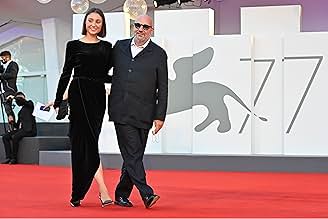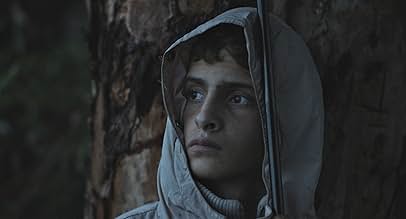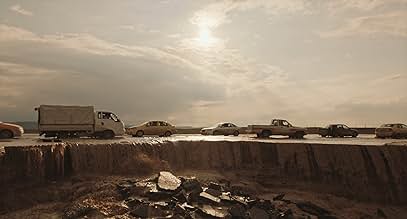IMDb RATING
6.6/10
1.4K
YOUR RATING
Gianfranco Rosi's new documentary is an immersive portrait of those trying to survive in the war-torn Middle East.Gianfranco Rosi's new documentary is an immersive portrait of those trying to survive in the war-torn Middle East.Gianfranco Rosi's new documentary is an immersive portrait of those trying to survive in the war-torn Middle East.
- Director
- Writer
- Awards
- 7 wins & 15 nominations total
Featured reviews
If you aren't blown away by the power of this maybe just stick to Hollywood CGI'd blockbusters. The lack of narration adds power to the heartbreaking stories of ordinary peoples lives in dire situations. If you're expecting to be spoon fed a happy ending just move on this isn't for you, reflection, empathy and questioning the status quo requires intelligence.
This movie sucks it's so boring. I could've done a better documentary with my android phone.
There are some scenes in this world that are just sitting still, awaiting for a person with a camera at hand to arrive and film, and the war-stricken fields and streets of Syria, Lebanon and Iraq undeniably fall into that category. Fortunately Gianfranco Rosi resolved to be that person with his skillfully placed cameram just letting those streets and fields tell the tale.
The film consists of several parallel sotries of people, remnants, survivors and soldiers moving simultaneously along. We are shown a boy maybe of 10 years try to survive by working dawn to dusk for mere five dollars, a group of women-soldiers guarding the borders who might just be some college student party-goers if they had more share of luck when born, a mental health ward of a hospital with a doctor and a crew of mentally-shaken patients and a group of kids with fallen parents living a life not identical to ours.
But the film- or the scenes- doesn't show these people as victims to be pitied or sympathized, but as alive and sentient humans trying their best to maintain thier poise and outplay thier unfortunate circumstances and that is the most moving part of this film.
the other very bold and stroking aspect of Rosi's work is how gorgeous and stunning it looks. The landscape shots are plenty and here and there are vistas so catchy that reminds us of this region's old glories. I had the chance to watch this work on silver screen and I think it it best served that way.
The film consists of several parallel sotries of people, remnants, survivors and soldiers moving simultaneously along. We are shown a boy maybe of 10 years try to survive by working dawn to dusk for mere five dollars, a group of women-soldiers guarding the borders who might just be some college student party-goers if they had more share of luck when born, a mental health ward of a hospital with a doctor and a crew of mentally-shaken patients and a group of kids with fallen parents living a life not identical to ours.
But the film- or the scenes- doesn't show these people as victims to be pitied or sympathized, but as alive and sentient humans trying their best to maintain thier poise and outplay thier unfortunate circumstances and that is the most moving part of this film.
the other very bold and stroking aspect of Rosi's work is how gorgeous and stunning it looks. The landscape shots are plenty and here and there are vistas so catchy that reminds us of this region's old glories. I had the chance to watch this work on silver screen and I think it it best served that way.
I don't know Rosi's work as a cameraman, but can imagine some directors like long takes in wide angle, especially when content is not the main thing. So this is documentary 'art' ? Three years of film-making and I see material that's general, could be anywhere, even an LA backwater. Certainly better on a big screen, but watch out if you have a comfortable chair too, as you might sleep and miss most of it.
Several years ago, Gianfranco Rosi lectured to an audience of university students (myself included) about his next project: it would be filmed exclusively at night, he said, and take place over much of the Middle East. He asked that we not release any of this information - assured of the secret pact with his audience. I had more or less forgotten about this project until recently, when I discovered it had been selected as the Italian entry for the Best International Feature Film at the 93rd Academy Awards, and was being distributed by MUBI.
Notturno ("night," or "of the night") is a collection of brief glimpses into the lives of people across Syria, Lebanon, Iraq and the Kurdistan region of northern Iraq. From dark swamplands to inner cities, fisherman, soldiers and teachers, to name a few, are brought into the documentary's compass. Few words are spoken by those selected, and much of their action or routine takes place in quietness - a sort of calm in the aftermath of a terrible storm. Rosi's observational and distant study only partly takes places at night; many scenes are filmed in the soft glow of dawn or twilight, and many in bright sunlight.
For a while, I was sceptical about the documentary's artistic license. There is near-perfect composition to each frame, and the theatrical recreation of war by the amateur, psychiatric patients reminded me of Joshua Oppenheimer's The Act of Killing (where civilians and dictators are made to dramatise the traumas of their past). And yet, I found myself compelled by Notturno's visual storytelling, by the sparseness of its landscapes and sound. There are stories within these images, and sometimes they need to speak for themselves, without the aid of conventional narration or voiceover.
Notturno ("night," or "of the night") is a collection of brief glimpses into the lives of people across Syria, Lebanon, Iraq and the Kurdistan region of northern Iraq. From dark swamplands to inner cities, fisherman, soldiers and teachers, to name a few, are brought into the documentary's compass. Few words are spoken by those selected, and much of their action or routine takes place in quietness - a sort of calm in the aftermath of a terrible storm. Rosi's observational and distant study only partly takes places at night; many scenes are filmed in the soft glow of dawn or twilight, and many in bright sunlight.
For a while, I was sceptical about the documentary's artistic license. There is near-perfect composition to each frame, and the theatrical recreation of war by the amateur, psychiatric patients reminded me of Joshua Oppenheimer's The Act of Killing (where civilians and dictators are made to dramatise the traumas of their past). And yet, I found myself compelled by Notturno's visual storytelling, by the sparseness of its landscapes and sound. There are stories within these images, and sometimes they need to speak for themselves, without the aid of conventional narration or voiceover.
Did you know
- TriviaOfficial submission of Italy for the 'Best International Feature Film' category of the 93rd Academy Awards in 2021.
- Quotes
Teacher: Tell me what you saw.
- How long is Notturno?Powered by Alexa
Details
Box office
- Gross worldwide
- $121,053
- Runtime1 hour 40 minutes
- Color
- Aspect ratio
- 1.85 : 1
Contribute to this page
Suggest an edit or add missing content



![Trailer [OV]](https://m.media-amazon.com/images/M/MV5BNzY2YTkyZGQtOWYwOS00MDRhLWEyZDctNWU0MGE2YzdmOGEwXkEyXkFqcGdeQXRyYW5zY29kZS13b3JrZmxvdw@@._V1_QL75_UX500_CR0)


















